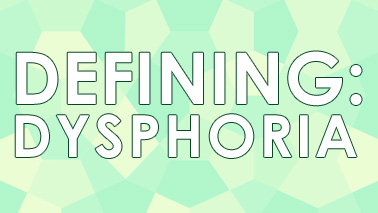
Defining: Gender Dysphoria
September 12, 2017 Jamey Alea 1 Comment
DEFINE IT:
The word “dysphoria” is defined as “a sense of being ill at ease or a feeling of dissatisfaction or anxiety.” That’s a pretty good characterization of what gender dysphoria is: feeling ill at ease or dissatisfied with one’s own gender. Most transgender people experience some level of gender dysphoria, and it’s often a huge factor in making the decision to transition (medically or socially) and live their lives as their true gender.
EXPLAIN IT:
There are a couple of different aspects of gender dysphoria: body dysphoria and social dysphoria. When people talk about gender dysphoria, they’re very often referring to the “body dysphoria” aspect—specifically a discomfort with their body, and the gendered characteristics that their body may have.
Of course, body dysphoria manifests very differently in different people. While a lot of people do have dysphoria about their genitalia, that’s certainly not the be-all-end-all. Dysphoria can also manifest around voice, facial hair, or curvy hips. Many trans-masculine people experience dysphoria about how large their chest is, while trans-feminine people often experience dysphoria about how flat their chest is. Some people are sensitive about their height or the size of their hands. Personally, the worst body dysphoria I’ve ever experienced was related to how I perceived myself as smelling. It can really manifest in curious ways—any physical characteristic that might prevent others from perceiving someone as their true gender is fair game for body dysphoria.
As previously mentioned, though, body dysphoria isn’t the only way gender dysphoria manifests. “Social dysphoria” refers to a discomfort with the way other people perceive—and therefore treat—you socially. Some trans people decide not to medically transition (and that’s okay!), but social dysphoria can still be a huge factor in their lives. As a nonbinary person, while I experience some physical body dysphoria, the social dysphoria that happens when I am not recognized as nonbinary is often much more devastating.
What do I mean when I say “the way other people perceive you”? An example might be being referred to by the wrong pronouns or name. For me, being invited to women’s only events, where I don’t feel like I belong, can also cause social dysphoria. Social dysphoria is what makes me worry about my feminine clothes or my colored hair. I’m afraid, despite liking those parts of myself, that they will cause people to perceive me as less masculine.
So, what’s the difference between body dysphoria and social dysphoria? Here’s an example: body dysphoria is when the phone rings, you answer and say hello, and the feminine sound of your voice is jarring and upsetting to you, perhaps like it should be someone else’s voice. Social dysphoria is the awkward moment when the person on the other end of the phone says in a confused voice, “Oh, I thought I was calling someone named James” and you have to reply, “Yes, this is James.”
Some trans people experience all of these aspects of gender dysphoria. Others only experience some. A lot of people experience different ones at different times, with ebbs and flows. No one specific way of experiencing dysphoria is more real or valid than any other way.
DEBUNK IT:
“Gender dysphoria isn’t a real thing! You’re just making it up!”
Not true! While scientists don’t know everything about what makes a trans person trans, studies have shown that sections of trans women’s brains can look more like cisgender women than cisgender men (and the same with trans men resembling cis men more closely than cis women)! This article from Harvard breaks some of this down in an understandable way and includes links to some studies that have been done.
“Well, nobody’s really happy with their body, are they? Isn’t that the same as experiencing dysphoria?”
Nope! Gender dysphoria is more than just not liking how you look, and it’s not something that will go away through focusing on body positivity and making peace with yourself. It’s why so many trans people are motivated to come out and transition.
Dysphoria is also not the same as body dysmorphia, which is a symptom associated with eating disorders, categorized by a perception of one’s own body that doesn’t match up with reality (like people thinking they’re heavier when they’re actually underweight). Dysphoria is related to one’s body not matching up with one’s sense of self. This explains why surgery has been proven to be very effective at combating many forms of dysphoria, while this is not the case when combating dysmorphia.
(This article was originally published on My Kid Is Gay.)
Comments